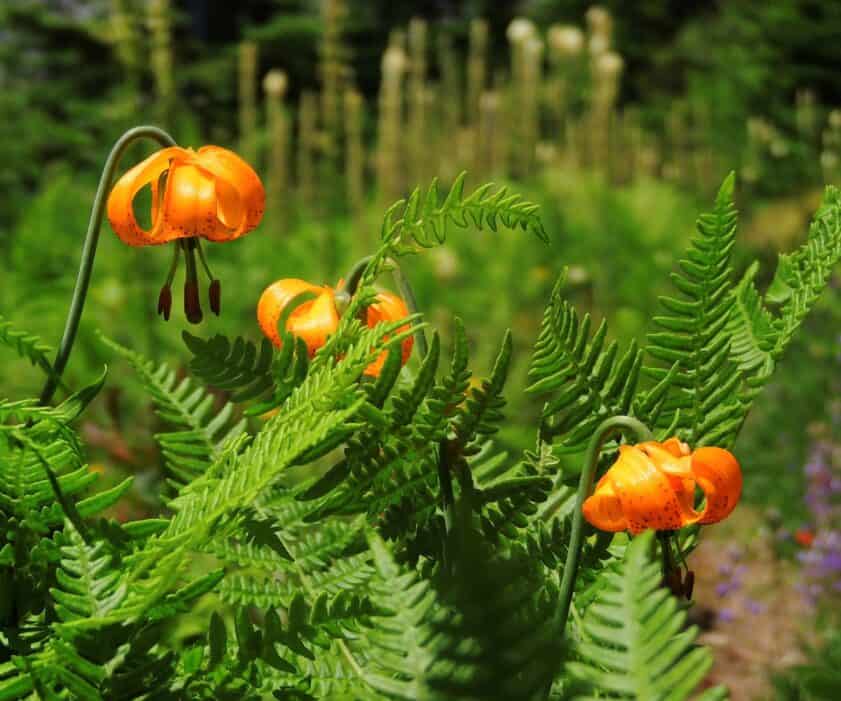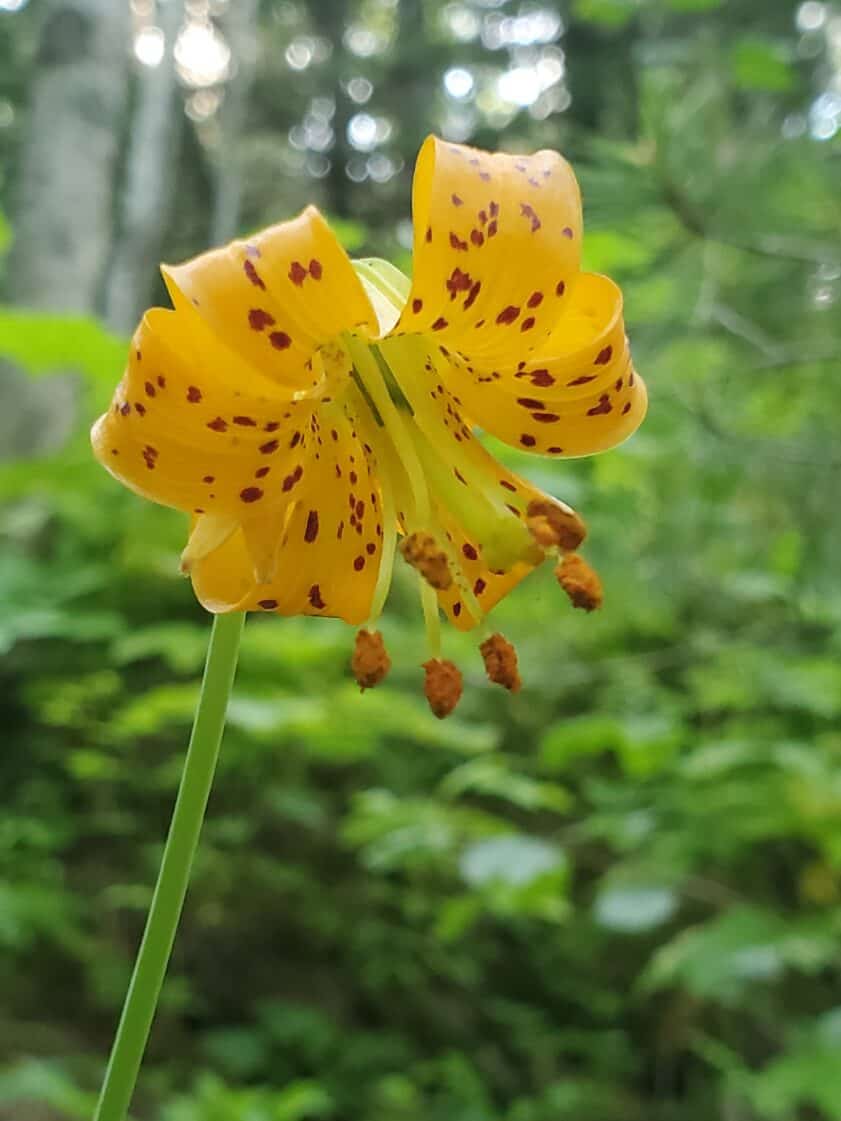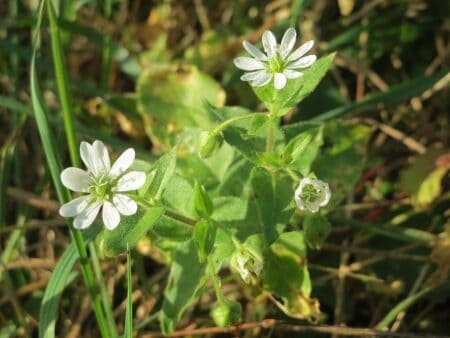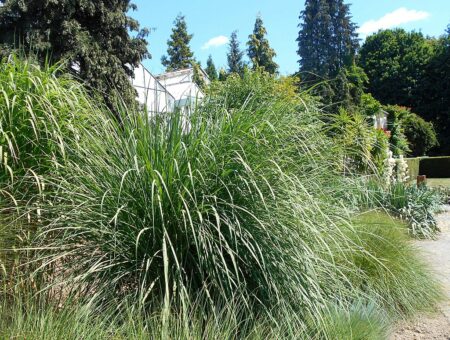Striking Tiger Lily, Lilium lancifolium or Lilium tigrinum, is a decorative plant native to eastern regions of Asia and the Russian Far East, including the islands of Kuril and Sakhalin and regions of Korea, China and Japan. The plant with typically orange flowers is adapted and cultivated today around the world.
However, there are many related hybrids and species within the Lilium genus. Crossing Lilium lancifolium with other species has created types of lilies with also red, pink, white and yellow flowers.
Tiger lily is a more profuse bloomer than most lilies: it produces up to 10 flowers per stem. Like many other lilies, the flowers of a tiger lily grow on upright stems that are 31–79 inches (80–200 cm) tall. The orange flower has black dots on its upward-curling petals.
The odorless blossom lasts a few days and produces a capsule with many thin seeds if pollinated. Narrow oval leaves are 2,5–4 inches (6–10 cm) long and up to an inch (1–2 cm) broad.
Grow & Care
Tiger lilies are mostly grown as decorative garden or landscape plants, but they can do well also in a cutting garden, in containers or indoors in a pot. It is also a great addition to a pollinator garden, as the flowers attract pollinators like bees, butterflies and even hummingbirds. Tiger lilies are toxic to cats, but not dogs.
The moderate growth rate tiger lily requires minimal care and is rather hardy. It is a perennial, meaning that it comes back every year, as long as it is well cared for. The bulbs can be planted in the fall or springtime. The plant blooms once a year during summertime and goes dormant for the winter.
Tiger lily tolerates both hot summer days and freezing winter temperatures, as long as the bulbs are deep enough in the ground to remain cool during heat and protected from the cold. During winter, covering the planting site with a couple of inches of mulch for insulation can contribute to a safe hibernation.

Climate
Tiger lilies tolerate a quite wide range of environments and temperatures. The native eastern-Asian plant can be grown in USDA hardiness zones 3–9. Tiger lilies prefer to grow in a sunny location with at least six hours of direct sun on most days, but will also tolerate partial shade.
The plant starts to grow in the spring, after the last frost. As long as the soil moisture is appropriate, tiger lilies can grow well in both dry and humid environments. When the incoming winter months bring lower temperatures, the plant goes dormant until the next spring.
Soil & Fertilizer
Tiger lilies prefer soil that’s fairly fertile and slightly acidic, though they can tolerate various soil types as long as it provides good drainage. You can amend your soil by mixing in some sand, straw or peat moss for improving drainage and retaining healthy moisture.
When you grow your tiger lilies in alkaline soils, feeding them with an acidifying fertilizer might be beneficial. Some humus or compost around the base of the plants once or twice a year is covering their nutritional needs, though additional fertilizing can encourage more flowering. When growing your lilies in a pot or a container, use a well-draining potting mix.

Watering
As it takes a few years for the root system to mature, young plants should be watered regularly and protected with a layer of mulch over the soil, which captures moisture and shields the bulbs from extreme heat. After a few years, the roots are developed enough and your lilies can better tolerate some drought, thus being fairly low-maintenance plants.
During dormancy, reduce watering and make sure the planting site doesn’t get waterlogged. Tiger lily bulbs need very little water during winter months, and excess moisture can become harmful, causing the bulbs and roots to rot.
Propagating
Even though tiger lily is not classified as an invasive species, its invasive growing tendencies make it spread easily in your garden. They tend to grow into dense clumps and may need to be divided every few years. You can divide bulbs before the growth season starts in spring or in the fall in warmer climates.
After carefully digging up the dormant plant, separate individual bulbs gently. For propagating purposes, replant the separated bulbs in a different location with the pointed side upwards.
It is also possible to grow a new plant from bulbils – the small, usually dark bulbs that grow on the parent plant’s stem during blooming. After ripening, these will be able to develop roots and grow into a new plant when placed in the soil.
Pruning
Tiger lilies should also be regularly “deadheaded”: removing spent flowers keeps the plant neat looking, encourages more blooms and prevents unwanted spreading, as the plant won’t seed.
Pruning the leaves is not necessary during the active growth period. In late summer, the foliage on the lower part of the stalks will be the first to start fading, and can be removed. Once all of the leaves on the plant have turned yellow, it is time to prepare your lily for dormancy: cut the stalks down to ground level and dispose of them.
Repotting
When growing tiger lilies in containers, select a pot that’s at least 8 inches (around 20 cm) wide and deep and has sufficient drainage holes. Unglazed clay is an ideal container material for a healthy moisture level in the soil, as it allows excess water to evaporate through its walls.
If you notice roots popping above the soil line or growing out of the drainage holes, you should repot or divide your plant. Tiger lilies are likely to get root-bound and might need repotting every few years.
Avoid overpotting though: when repotting, position the plant at the same depth as it was in its previous pot, but allow for a couple of inches (3–4 cm) between the root ball and container wall. Fill this space evenly with fresh potting mix.
Diseases & Pests
Tiger lilies are a resilient species and thus are not very susceptible to disease. However, they can still get infected with viruses and infested by pests. Aphids and botrytis can cover the plant or be seen accumulating on the surface of the leaves. Cleaning the stems and leaves gently with soapy water and rubbing with neem oil gets rid of these.
There are also some viruses with no cure, such as the lily mosaic virus, in which case the plant, including the bulb, should be pulled and destroyed. It is not recommended to add infected plants to your compost, as the virus can survive and keep spreading. The most obvious symptom of mosaic virus is discoloration of the leaves: they appear patchy with dark and light green, or even yellow and brown.
Lilies can also get infested by a pest with many names: lily leaf beetle, red lily beetle or scarlet lily beetle (Lilioceris lilii). These bugs eat the blossoms, buds, stems and leaves of plants of the family Liliaceae.
There are many options for controlling these colorful pests: try treating the plant with a domestic insecticide for general leaf beetle, neem extract-based products or thiacloprid, which is an insecticide of the neonicotinoid class. Regular handpicking and crushing of the bugs and eggs is also an effective, yet laborious way of controlling populations.
Growth Problems
If your tiger lily’s foliage is yellowing, it can indicate an issue with watering. If the plant appears droopy and has little to no blooms, your plant may be overwatered or suffering from poor soil drainage. Reduce watering and let the top few inches of soil dry completely before watering again. If the condition of your plants does not seem to improve, digging up the plants and amending the soil with sand, straw or peat moss may be needed.
Though it is important to remember that foliage yellowing is completely normal during autumn, when the plant is nearing winter dormancy.
Last Thoughts
The striking appearance and hardy nature make tiger lily a fairly common plant in gardens and parks all around the world. In some parts of Asia, tiger lily is cultivated and wild foraged also for its medicinal use: edible bulbs are anti-inflammatory and are used for treating heart diseases, pain in the heart area and angina pectoris. Healing properties and uses vary widely depending on the exact species of the lily, so thorough research is surely recommended.
Perennial tiger lilies will bring color and attract pollinators to your garden for years, making them a rather low-maintenance and rewarding addition to your flower beds.
















